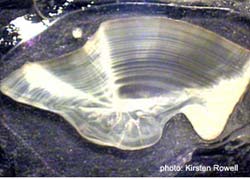Long before a Hollywood blockbuster about catastrophic climate change packed cinema multiplexes this spring, researchers at the top of the world, supported by the National Science Foundation (NSF), were using an array of scientific tools to build a comprehensive scientific picture of environmental change in the Arctic and what it may mean for the rest of the globe. Led by oceanographer James Morison, of the University of Washington, NSF-supported scientists from Oregon State University, as we
Old fish bones can tell scientists about more than what people used to eat. They can also provide clues to the climate in which those people lived. In the scientific journal Quaternary Research, a team led by three University of Maine scientists reports using fish bones from an archaeological site in Peru to describe the timing of Pacific Ocean climate cycles linked to El Nino.
The report provides new evidence for a theory stating that biological cycles in the world’s oceans reflect su
New reserach by Columbia University
For years, researchers have examined climate records indicating that millennial-scale climate cycles have linked the high latitudes of the Northern hemisphere and the subtropics of the North Pacific Ocean. What forces this linkage, however, has been a topic of considerable debate. Did the connection originate in the North Pacific with the sinking of oxygen-rich waters into the interior of the ocean during cool climate intervals, or did it originate

NASA and University of Maryland scientists have found the African monsoon consists of two distinct seasons The first season is in the late spring and early summer. The rain is concentrated on the West African Coast near the Gulf of Guinea, five degrees north of the equator. This season appears strongly influenced by sea surface temperatures off the coast of West Africa. The second season arrives later in summer in July at around 10 degrees north of the equator. Atmospheric wa

During their tender youth, both the endangered fish species totoaba and the commercially important gulf corvina require the brackish water habitat provided by the shrinking Colorado River estuary, report researchers.
Although overfishing has been implicated in the decline of both species, commercial harvesting isn’t the only reason for the two species’ decline, the finding suggests. Since 1960, diversion of Colorado River water for human uses has greatly reduced the amount of fresh water t
Situated between the continental shelf of the eastern United States and the north wall of the Gulf Stream flowing eastward from Cape Hatteras, the Slope Sea is a transition region between the productively rich coastal waters and the productively static open ocean.
In the current SeaWiFS special issue of Deep Sea Research II, University of Rhode Island oceanographers Stephanie E. Schollaert, Thomas Rossby, and James Yoder describe their four-year, NASA-funded study of the Slope Sea along the